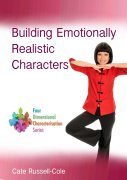Plot tips: One Way to Write About Phobias
Phobias are the worst kind of nightmare: they strike when you are awake. No noise from outside your bedroom window will wake you and release you from your nightmare. There may be no escape. They can utterly disable your most heroic character. I’d like to describe a phobia to you from my own experience, challenging the myth that all phobias are irrational.
 I have a problem with needles. I can watch television programs on surgery and be fine with scalpels, saws etc., but if a doctor picks up a needle, I cannot watch. As a child I was put through 36 blood tests and two invasive tests in two days. Once, I was threatened that if I moved, a needle could go right through my arm. I was only ten years old. After that, no one could come at me with any form of needle.
I have a problem with needles. I can watch television programs on surgery and be fine with scalpels, saws etc., but if a doctor picks up a needle, I cannot watch. As a child I was put through 36 blood tests and two invasive tests in two days. Once, I was threatened that if I moved, a needle could go right through my arm. I was only ten years old. After that, no one could come at me with any form of needle.
I will fight you as if you were holding a gun to my head. I break into a cold sweat; shake as my pulse rate rises; start breathing heavily; and my brain goes into a narrow focus, looking for an escape route. For me, it’s so opposed to my normal behavior, that it’s like turning into a werewolf. I have frightened pre-warned, seasoned Pathologists with my desperation to escape. Hysteria is not out of the question if you try to hold me down. It is pure torture: all for a small, quick pain which is pathetically minimal, compared to my migraines! It’s crazy, but it’s not crazy. Phobias can be a paradigm.
People are understanding. Many have offered to hold my hand to make it better. They don’t realize that it wouldn’t help; they’d just become an enemy to fight. It is about safety and control. You cannot distract me, bribe me, talk me out of it, threaten me: I will write off your opinion and leave, because getting that blood test done matters to you, but not to me. I got away. I survived without harm. I won! I have little control over it, despite the fact that I want and need to control it.

So I have a phobia I can partially rationalise. Yes, logically, I know not every needle would hurt me. Then how do you explain phobias which seem to come out of the blue? The lady with a phobia of birds who rarely leaves her house; someone who is paralysed by snakes but has never met one; a person terrified of any form of paper; or someone with a fear of heights when they have never actually fallen? Somewhere, a memory must be laying hidden. Something could have been said or shown to them which instilled fear. Perhaps they had a terrifying experience which is forgotten? You would think a big trauma would be remembered, but it doesn’t work that way. The brain can shut scares out as a defence mechanism. The incident which gave rise to the phobia, may not be able to be recalled.
How people cope with fear has no formula. Some will “feel the fear and do it anyway,” even if they are in serious danger. Others will hide from a bee that is a few feet away. How do you explain the difference? You can’t. That makes fear a fascinating area for writers to explore.
P.S. I have utterly hated writing and editing this post. It was written last October and I have pushed it back and back as I don’t want to see it on my blog. That is how strongly I feel about it. Plus you will notice that the syringes above do not have a visible needle on them. They are capped! Research has been done on needle fears as they are so prevalent, particularly if Dental appointments are involved. It is thought there may be an involuntary physiological reaction which kicks in as the body is pierced which gives rise to this phobia. In the future, who knows how many other phobias there may be more scientific explanations for. For more information, please visit: http://www.needlephobia.com

 This post is a chapter from “Building Emotionally Realistic Characters.” Whether you are writing fiction, memoir, poetry, short stories, plays, screenplays or music, the ability of your work to touch others depends on how they relate to the messages you are conveying. What they see and hear must be something they have encountered and can relate to easily; or it must be shared in another way they can grasp. Often that is done through the only common element every human being has: knowing what emotions feel like.
This post is a chapter from “Building Emotionally Realistic Characters.” Whether you are writing fiction, memoir, poetry, short stories, plays, screenplays or music, the ability of your work to touch others depends on how they relate to the messages you are conveying. What they see and hear must be something they have encountered and can relate to easily; or it must be shared in another way they can grasp. Often that is done through the only common element every human being has: knowing what emotions feel like.
You can read a story about events which have never happened to you, but still laugh or cry over what is occurring with the characters. Why? Because you know what it is to experience pain, joy, fear, rejection, envy, fatigue, laughter, grief, ecstasy or doubt too. This is the magic that makes stories work. The tricky part, is conjuring up the right spell or your reader will not be fooled.
This e-book is a full of the incantations you need to bring your characters to life in a way that is emotionally realistic. There are no short cuts to “happily ever after” endings, which leave your plot line hollow and sounding fake. The book contains introductory level psychology which will give you an insight into how emotions and events weave us together into a whole or hurting person.
Chapters include change, motivation, recovering from trauma, post traumatic growth, grief, shock, arrogance and insecurity, escapism, fatal flaws, phobias, shame, violence, suicide prevention, personality types, schizophrenia and multiple personality disorder. Available from Amazon Kindle.
This article / blog post is Copyright Cate Russell-Cole 2013. All rights are reserved Internationally. You may not reproduce it in any form, in part of whole, without Cate’s prior written permission. That includes usage in forms such as print, audio and digital imaging including pdf, jpg, png etc. A fee may be requested for re-using her work if it is for a commercial venture. Link sharing and Pinterest pins are most welcome as long as Cate is the attributed Author.
No images on this blog may be copied, captured, or altered for your own purpose without the consent of the originating owner. Where images are marked as being iStockphoto.com images, they are paid for and licenced to Cate for use on this blog. If you take them, iStockphoto.com has the right to take legal action against you for Copyright Infringement.
Please see the Blog Content and Image Copyright page of this blog for further information in regards to Guest Posts, other images, Cate’s checks on infringements and Liability.
Filed under: Writing Resources Tagged: behaviour, characterisation, fear, fiction, ideas, Indie publishing, mind, myth, novel, phobia, plot, psychology, stress, writer, writing












